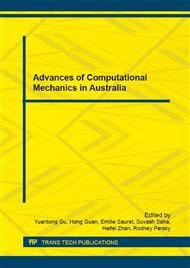p.245
p.251
p.258
p.264
p.270
p.276
p.282
p.288
p.294
Two-Layer Red Blood Cell Membrane Model Using the Discrete Element Method
Abstract:
The red blood cell (RBC) membrane consists of a lipid bilayer and spectrin-based cytoskeleton, which enclose haemoglobin-rich fluid. Numerical models of RBCs typically integrate the two membrane components into a single layer, preventing investigation of bilayer-cytoskeleton interaction. To address this constraint, a new RBC model which considers the bilayer and cytoskeleton separately is developed using the discrete element method (DEM). This is completed in 2D as a proof-of-concept, with an extension to 3D planned in the future. Resting RBC morphology predicted by the two-layer model is compared to an equivalent and well-established composite (one-layer) model with excellent agreement for critical cell dimensions. A parametric study is performed where area reduction ratio and spring constants are varied. It is found that predicted resting geometry is relatively insensitive to changes in spring stiffness, but a shape variation is observed for reduction ratio changes as expected.
Info:
Periodical:
Pages:
270-275
Citation:
Online since:
July 2016
Authors:
Price:
Сopyright:
© 2016 Trans Tech Publications Ltd. All Rights Reserved
Share:
Citation:


